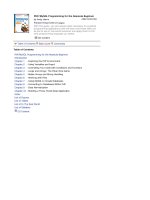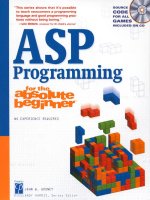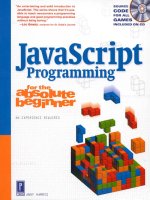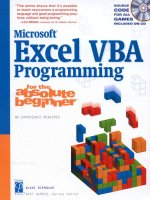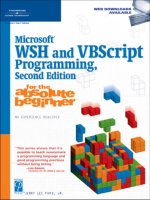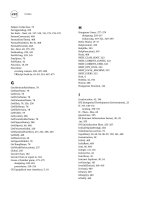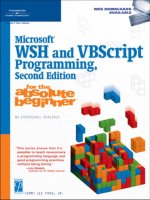C Programming for the Absolute Beginner phần 2 ppsx
Bạn đang xem bản rút gọn của tài liệu. Xem và tải ngay bản đầy đủ của tài liệu tại đây (1.31 MB, 28 trang )
A simple correction to the comment block, shown next, will solve the issue and allow the
program to compile successfully.
/* This corrects the previous comment block error */
S
UMMARY
• Functions allow you to group a logical series of activities, or program statements, under
one name.
• Functions can take in and pass back information.
• An algorithm is a finite step-by-step process for solving a problem.
• Each function implementation requires that you use a beginning brace (
{) and a closing
brace (
}).
• Comments help to identify program purpose and explain complex routines.
• The character set
/* signifies the beginning of a comment block and the character set
*/ identifies the end of a comment block.
• There are 32 words defined as keywords in the standard ANSI C programming language;
these keywords have predefined uses and cannot be used for any other purpose in a C
program.
• Most program statements control program execution and functionality and may require
a program statement terminator (
;).
• Program statements that do not require a terminator include preprocessor directives,
comment blocks, and function headers.
•The
printf() function is used to display output to the computer screen.
• When combined with the backslash (
\), special characters such as n make up an escape
sequence.
• The library name
stdio.h is short for standard input output and contains links to various
standard C library functions, such as
printf().
• C compilers such as gcc preprocess program code, generate error codes and messages if
applicable, compile program code into object code, and link any necessary libraries.
• Compile errors are generally the result of syntax issues, including missing identifiers
and terminators, or invalid directives, escape sequences, and comment blocks.
• A single error at the top of your program can cause cascading errors during compile
time.
• The best place to start debugging compile errors is with the first error.
24
C Programming for the Absolute Beginner, Second Edition
Challenges
1. Study the VIM Quick Guide as described in Appendix B.
2. Study the nano Quick Guide as described in Appendix C.
3. Create a program that prints your name.
4. Create a program that uses escape sequence
\"
to print your
favorite quote.
5. Create a program that uses escape sequence
\\
to print the fol-
lowing directory structure:
c:\cygwin\home\administrator
.
6. Write a program that prints a diamond as demonstrated next.
*
* *
* *
* *
* *
* *
*
7. Create a calendar program using the current month (similar to
the one shown in Figure 1.6).
Chapter 1 • Getting Started with C Programming
25
This page intentionally left blank
2
C HAP TE R
PRIMARY DATA TYPES
his chapter investigates essential computer memory concepts, as well as
how to get information from users and store it as data using C language
data types. In addition to beginning data types, you will also learn how to
display variable contents using the
printf()
function and to manipulate data
stored in variables using basic arithmetic. Specifically, this chapter covers the
following topics:
• Memory concepts
•Data types
• Initializing variables and the assignment operator
• Printing variable contents
•Constants
• Programming conventions and styles
•
scanf()
•Arithmetic in C
• Operator precedence
T
MEMORY CONCEPTS
A computer’s memory is somewhat like a human’s, in that a computer has both short-term
and long-term memory. A computer’s long-term memory is called nonvolatile memory and is
generally associated with mass storage devices, such as hard drives, large disk arrays, optical
storage (CD/DVD), and of course portable storage devices such as USB flash or key drives. In
Chapters 10 and 11, you will learn how to use nonvolatile memory for storing data.
This chapter concentrates on a computer’s short-term, or volatile, memory. Volatile memory
loses its data when power is removed from the computer. It’s commonly referred to as RAM
(random access memory).
RAM is comprised of fixed-size cells with each cell number referenced through an address.
Programmers commonly reference memory cells through the use of variables. There are many
types of variables, depending on the programming language, but all variables share similar
characteristics, as described in Table 2.1.
TABLE 2.1 COMMON VARIABLE CHARACTERISTICS
Variable Attribute Description
Name The name of the variable used to reference data in program code
Type The data type of the variable (number, character, and so on)
Value The data value assigned to the memory location
Address The address assigned to a variable, which points to a memory cell location
Using the attributes defined in Table 2.1, Figure 2.1 depicts the graphical relationship for
some common data types. Note that the letters and numbers in the “Memory Address” column
in Figure 2.1, such as
FFF4
, represent memory locations in the hexadecimal numbering sys-
tem. The hexadecimal numbering system is sometimes used in advanced C programming to
reference concise memory addresses, such as during system-level programming.
FIGURE 2.1
Depicting
common variable
attributes and
sample values.
28
C Programming for the Absolute Beginner, Second Edition
DATA TYPES
You will discover many data types in your programming career, such as numbers, dates,
strings, Boolean, arrays, objects, and data structures. Although this book covers some of the
aforementioned data types in later chapters, this chapter will concentrate on the following
primary data types:
• Integers
• Floating-point numbers
•Characters
Integers
Integers are whole numbers that represent positive and negative numbers, such as 3, 2, 1,
0, 1, 2, and 3, but not decimal or fractional numbers.
Integer data types hold a maximum of four bytes of information and are declared with the
int
(short for integer) keyword, as shown in the following line of code.
int x;
In C, you can declare more than one variable on the same line using a single
int
declaration
statement with each variable name separated by commas, as demonstrated next.
int x, y, z;
The preceding variable declaration declares three integer variables named
x
,
y
, and
z
. Remem-
ber from Chapter 1 that executable program statements such as a print statement or in this
case a variable declaration require a statement terminator (
;
).
Floating-Point Numbers
Floating-point numbers are all numbers, including signed and unsigned decimal and fractional
numbers. Signed numbers include positive and negative numbers whereas unsigned numbers
can only include positive values. Examples of floating-point numbers are shown in the
following list.
• 09.4543
• 3428.27
• 112.34329
• -342.66
• -55433.33281
Chapter 2 • Primary Data Types
29
−−−
Use the keyword
float
to declare floating-point numbers, as shown next.
float operand1;
float operand2;
float result;
The preceding code declares three floating-point variable data types called
operand1
,
operand2
, and
result
.
Characters
Character data types are representations of integer values known as character codes. For exam-
ple, the character code 90 represents the letter Z. Note that the letter Z is not the same as the
character code 122, which represents the letter z (lowercase letter z).
Characters represent more than just the letters of the alphabet; they also represent numbers
0 through 9, special characters such as the asterisk (*), and keyboard keys such as the Del
(delete) key and Esc (escape) key. In all, there are a total of 128 common character codes
(0 through 127), which make up the most commonly used characters of a keyboard.
Character codes are most notably organized through the ASCII (American Standard Code for
Information Interchange) character set. For a listing of common ASCII character codes, see
Appendix D, “Common ASCII Character Codes.”
ASCII
ASCII
or American Standard Code for Information Interchange is noted for its character set,
which uses small integer values to represent character or keyboard values.
In C, character variables are created using the
char
(short for character) keyword as demon-
strated next.
char firstInitial;
char middleInitial;
char lastInitial;
Character data assigned to character variables must be enclosed in single quotes (
'
), also
known as tick marks or apostrophes. As you’ll see in the next section, the equal sign (
=
) is used
for assigning data to the character variable.
30
C Programming for the Absolute Beginner, Second Edition
You cannot assign multiple characters to a single character variable type. When
more than one character is needed for storing a single variable, you must use
a character array (discussed in Chapter 6, “Arrays”) or strings (discussed in
Chapter 8, “Strings”).
INITIALIZING VARIABLES AND THE ASSIGNMENT OPERATOR
When variables are first declared, the program assigns the variable name (address pointer) to
an available memory location. It is never safe to assume that the newly assigned variable
location is empty. It’s possible that the memory location contains previously used data (or
garbage). To prevent unwanted data from appearing in your newly created variables, initialize
the new variables, as shown below.
/* Declare variables */
int x;
char firstInitial;
/* Initialize variables */
x = 0;
firstInitial = '\0';
The preceding code declares two variables: one integer and one character data type. After
creating the two variables, I initialize them to a particular value. For the integer variable, I
assign the value zero (
0
), and for the character data type, I assign the character set
\0
, which
is known as the
NULL
character.
Notice that in the character variable data assignment I enclosed the
NULL
character in single
quotes. Single quotes are required when assigning data to the character data type.
The
NULL
data type is commonly used to initialize memory locations in programming lan-
guages, such as C, and relational databases, such as Oracle and SQL Server.
Although
NULL
data types are a common computer science concept, they can be confusing.
Essentially,
NULL
characters are unknown data types stored in a memory location. However,
it is not proper to think of
NULL
data as empty or void; instead, think of
NULL
data as simply
undefined.
When assigning data to variables such as variable initialization, the equal sign is not used in
a comparative sense. In other words, you would not say that x equals 0. Rather, programmers
say variable
x
is taking on the value of
0
.
Remember, when assigning data to variables, such as initializing, you refer to the equal sign
as an assignment operator, not a comparison operator.
CAUT
ION
Chapter 2 • Primary Data Types
31
You can also initialize your variables while declaring them, as shown next.
int x = 0;
char firstInitial = '\0’;
The preceding code accomplishes the same tasks in two lines as what the following code
accomplishes in four.
int x;
char firstInitial;
x = 0;
firstInitial = '\0';
PRINTING VARIABLE CONTENTS
To print the contents of variables, use the
printf()
function with a few new formatting
options, as demonstrated in the following code block.
#include <stdio.h>
main()
{
//variable declarations
int x;
float y;
char c;
//variable initializations
x = -4443;
y = 554.21;
c = 'M';
//printing variable contents to standard output
printf("\nThe value of integer variable x is %d", x);
printf("\nThe value of float variable y is %f", y);
printf("\nThe value of character variable c is %c\n", c);
}
32
C Programming for the Absolute Beginner, Second Edition
First, I declare three variables (one integer, one float, and one character), and then I initialize
each of them. After initializing the variables, I use the
printf()
function and conversion
specifiers (discussed next) to output each variable’s contents to the computer screen.
The preceding code is a complete C program that demonstrates many of the topics discussed
thus far (its output is shown in Figure 2.2.).
FIGURE 2.2
Printing variable
contents.
CONVERSION SPECIFIERS
Because information is stored as unreadable data in the computer’s memory, programmers
in C must specifically tell input or output functions, such as
printf()
, how to display the data
as information. You can accomplish this seemingly difficult task using character sets known
as conversion specifiers.
Conversion specifiers are comprised of two characters: The first character is the percent
sign (
%
), and the second is a special character that tells the program how to convert the data.
Table 2.2 describes the most common conversion specifiers for the data types discussed in
this chapter.
TABLE 2.2 COMMON CONVERSION SPECIFIERS USED WITH
PRINTF
()
Conversion Specifier Description
%d
Displays integer value
%f
Displays floating-point numbers
%c
Displays character
Chapter 2 • Primary Data Types
33
Displaying Integer Data Types with printf()
Integer data types can easily be displayed using the
%d
conversion specifier with a
printf()
statement as shown next.
printf("%d", 55);
The output of the preceding statement prints the following text:
55
The
%d
conversion specifier can also be used to output the contents of a variable declared as
integer data type, as demonstrated next.
int operand1;
operand1 = 29;
printf("The value of operand1 is %d", operand1);
In the preceding statements, I declare a new integer variable called
operand1
. Next, I assign
the number
29
to the newly created variable and display its contents using the
printf()
func-
tion with the
%d
conversion specifier.
Each variable displayed using a
printf()
function must be outside the parentheses and sep-
arated with a comma (
,
).
Displaying Floating-Point Data Types with printf()
To display floating-point numbers, use the
%f
conversion specifier demonstrated next.
printf("%f", 55.55);
Here’s another example of the
%f
conversion specifier, which prints the contents of a floating-
point variable:
float result;
result = 3.123456;
printf("The value of result is %f", result);
Although the
%f
conversion specifier displays floating-point numbers, it may not be enough
to display the floating-point number with correct or wanted precision. The following
printf()
function demonstrates the precision problem.
printf("%f", 55.55);
This
printf()
example outputs a floating-point number with a six-digit precision to the right
of the decimal point, as shown next.
55.550000
34
C Programming for the Absolute Beginner, Second Edition
To create precision with floating-point numbers, adjust the conversion specifier using num-
bering schemes between the
%
sign and the
f
character conversion specifier.
printf("%.1f", 3.123456);
printf("\n%.2f", 3.123456);
printf("\n%.3f", 3.123456);
printf("\n%.4f", 3.123456);
printf("\n%.5f", 3.123456);
printf("\n%.6f", 3.123456);
The preceding code block produces the following output:
3.1
3.12
3.123
3.1234
3.12345
3.123456
Notice that I’ve included the escape sequence
\n
in each of the preceding print statements
(except the first line of code). Without the new line (
\n
) escape sequence, each statement’s
output would generate on the same line, making it difficult to read.
Displaying Character Data Types with printf()
Characters are also easy to display using the
%c
conversion specifier.
printf("%c", 'M');
The output of this statement is simply the single letter
M
. Like the other conversion specifiers,
you can output the contents of a character variable data type using the
%c
conversion specifier
and a
printf()
function as demonstrated next.
char firstInitial;
firstInitial = 'S';
printf("The value of firstInitial is %c", firstInitial);
You can use multiple conversion specifiers in a single
printf()
function:
char firstInitial, middleInitial, lastInitial;
firstInitial = 'M';
middleInitial = 'A';
lastInitial = 'V';
printf("My Initials are %c.%c.%c.", firstInitial, middleInitial, lastInitial);
Chapter 2 • Primary Data Types
35
The output of the preceding program statements is as follows.
My Initials are M.A.V.
Notice in the statement below that each variable displayed with the
printf()
function is
outside the double quotes and separated with a single comma.
printf("My Initials are %c.%c.%c.", firstInitial, middleInitial, lastInitial);
Text inside of
printf()
’s double quotes is reserved for displayable text, conversion specifiers,
and escape sequences.
CONSTANTS
Often referred to as read-only variables, constant data types cannot lose their data values
during program execution. They are most commonly used when you need to reuse a common
data value without changing it.
Constant data values can be of many data types but must be assigned when the constant is
first created, as demonstrated next.
const int x = 20;
const float PI = 3.14;
Notice that the keyword
const
precedes the data-type name, signaling that this is a read-only
variable or constant. You can print the values of constants in the same way that normal vari-
ables are printed using conversion specifiers with the
printf()
function as shown in the
following program code:
#include <stdio.h>
main()
{
const int x = 20;
const float PI = 3.14;
printf("\nConstant values are %d and %.2f\n", x, PI);
}
Figure 2.3 demonstrates the output of the preceding code block.
36
C Programming for the Absolute Beginner, Second Edition
FIGURE 2.3
Printing constant
data-type values.
PROGRAMMING CONVENTIONS AND STYLES
If someone hasn’t already mentioned this to you, let me be the first to say that programming
is as much of an art as it is a science! Your programs are a reflection of you and should reveal
a smooth and consistent style that guides the reader’s eyes through algorithms and program
flow. Just as a bridge provides function, it can also provide beauty, eye candy for both the
structural engineer as well as the traveler.
You should stick with a style and convention that allow you or someone else to easily read
your code. Once you pick or become comfortable with a programming style, the name of the
game is consistency. In other words, stick with it, don’t intermix naming conventions for
variables nor intermingle indenting styles within the same program.
When learning how to program you should specifically consider at least two areas to develop
a consistent programming convention and style.
• White space
• Variable naming conventions
White Space
White space is not often discussed in programming circles as it provides no computing ben-
efits. In fact, the compiler ignores white space, so you’re free to treat it as you may. So what
is white space? Philosophically speaking, white space is your programming canvas. Misused
it can strain the reader’s eyes; painted properly it can be a benefit. A few examples of how
white space can be controlled are with braces and indentation.
Chapter 2 • Primary Data Types
37
Indentation is a must as it guides your eyes in and out of program control. For example,
looking at the following sample
main() function, your eyes quickly tell you the code inside
the function logically belongs to it.
main()
{
//you code in here
}
A common discussion around indentation is the age old argument of tabs versus spaces. This
argument can be settled pretty easily in favor of spaces. The rationale behind this favor is
based on the fact that tabs can be set to take up various columns. Another programmer open-
ing your code might not have the same number of columns set for her tabs and consequently
the formatting will be off.
Another common question with beginning programmers is how far to indent. Personally, I
prefer an indentation of two to four spaces. An indentation of longer than four spaces will
eventually lead to lines that are too long. The goal here is to maintain a consistent indentation
style that keeps the lines of code on the computer screen.
One more thing to consider regarding white space is your brace styles, which are closely tied
to your indentation style. Just as with indentation, there are a number of brace styles, though
you will likely favor either this one
main()
{
//you code in here
}
or this one
main(){
//your code in here
}
As with any style the choice is yours, though I recommend balancing a style both comfortable
to you as well as consistent with what others are using on your team.
Variable Naming Conventions
The following list contains a minimal number of guidelines you should follow when declaring
and naming your variables.
38
C Programming for the Absolute Beginner, Second Edition
• Identify data types with a prefix.
• Use upper- and lowercase letters appropriately.
• Give variables meaningful names.
There is no one correct way of implementing a nomenclature for your variable names,
although some are better than others. After identifying your naming standards, the most
important process is to stay consistent with those practices throughout each of your
programs.
In the next few sections, I’ll show you a couple of different ways that have worked for me and
for many other programmers who have used the guidelines in the preceding list.
reserved characters in your variable names. As a general rule, abide by the fol-
lowing suggestions:
TRAP
Chapter 2 • Primary Data Types
39
•
Always begin your variable names with a lowercase letter.
•
Do not use spaces in your variable names.
•
Only use letters, numbers, and underscores (_) in your variable names.
•
Keep variable names fewer than 31 characters to maintain ANSI C
standards.
Identifying Data Types with a Prefix
When working with variables, I tend to choose one of three types of prefixes, as demonstrated
next.
int intOperand1;
float fltResult;
char chrMiddleInitial;
For each variable data type, I choose a three-character prefix, int (short for integer), flt (short
for float), and
chr (short for character), for my variable name prefixes. When I see these vari-
ables in my program code, I know instantly what data types they are.
Another way of prefixing your integer data types is to use a single-character prefix, as shown
in the second variable declarations.
int iOperand1;
float fResult;
char cMiddleInitial;
Even though these variables don’t scream out their data types, you can see their prefix easily
when trying to determine variable content type. Also, these single-character prefixes work
very well when used in conjunction with appropriate upper- and lowercase letters, as dis-
cussed in the next section.
In addition to adhering to a variable naming convention, be cautious not to use
Using Uppercase and Lowercase Letters Appropriately
Capitalizing the first character of each word in a variable name (as shown in the following
float fNetSalary;
char cMenuSelection;
int iBikeInventoryTotal;
Using uppercase characters in each word makes it very easy to read the variable name and
identify its purpose. Now, take a look at the same variables with the same name, only this
time without using uppercase characters.
float fnetsalary;
char cmenuselection;
int ibikeinventorytotal;
Which variable names are easier to read?
In addition to using uppercase letters for readability, some programmers like to use the
underscore character to break up words, as shown in the following code.
float f_Net_Salary;
char c_Menu_Selection;
int i_Bike_Inventory_Total;
Using the underscore character certainly creates a readable variable, but it is a bit too cum-
bersome for me.
Constant data types provide another challenge for creating a standard naming convention.
Personally, I like the following naming conventions.
const int constWeeks = 52;
const int WEEKS = 52;
In the first constant declaration I use the
const
prefix for identifying
constWeeks
as a constant.
Notice, though, that I still capitalize the first letter in the constant name for readability
purposes.
In the second declaration, I simply capitalize every letter in the constant name. This naming
style really stands out.
40
C Programming for the Absolute Beginner, Second Edition
code) is the most common and preferred variable naming convention.
Give Variables Meaningful Names
Giving your variables meaningful names is probably the most important part of variable
naming conventions. Doing so creates self-documenting code. Consider the following section
of code, which uses comments to describe the variable’s purpose.
int x; //x is the Age
int y; //y is the Distance
int z; //z is the Result
The preceding variable declarations do not use meaningful names and thus require some
form of documentation to make your code’s purpose understandable. Instead, look at the
following self-documenting variable names.
int iAge;
int iDistance;
int iResult;
So far, you have learned how to send output to the computer’s screen using the
printf()
function. In this section, you will learn how to receive input from users through the
scanf()
function.
The
scanf()
function is another built in function provided by the standard input output
library
<stdio.h>
; it reads standard input from the keyboard and stores it in previously
declared variables. It takes two arguments as demonstrated next.
scanf("conversion specifier", variable);
The conversion specifier argument tells
scanf()
how to convert the incoming data. You can
use the same conversion specifiers as discussed in Table 2.2, and shown again as relative to
scanf()
in Table 2.3.
TABLE 2.3 COMMON CONVERSION SPECIFIERS USED
WITH SCANF
()
Conversion Specifier Description
%d Receives integer value
%f Receives floating-point numbers
%c Receives character
Chapter 2 • Primary Data Types
41
scanf()
The following code represents a complete C program, the Adder program, which uses the
scanf()
function to read in two integers and add them together. Its output is shown in
Figure 2.4.
#include <stdio.h>
main()
{
int iOperand1 = 0;
int iOperand2 = 0;
printf("\n\tAdder Program, by Michael Vine\n");
printf("\nEnter first operand: ");
scanf("%d", &iOperand1);
printf("Enter second operand: ");
scanf("%d", &iOperand2);
printf("The result is %d\n", iOperand1 + iOperand2);
}
FIGURE 2.4
Using scanf() to
receive input from
a user.
The first notable line of code prompts the user to enter a number.
printf("\nEnter first operand: ");
You may notice that the
printf
function above does not contain a variable at the end, nor
does it include the escape sequence
\n
at the end of the statement. By leaving the new line
42
C Programming for the Absolute Beginner, Second Edition
escape sequence off the end of a print statement, program control pauses while waiting for
user input.
The next line of code uses the
scanf()
function to receive input from the user.
scanf("%d", &iOperand1);
The first
scanf()
argument takes the integer conversion specifier (
"%d"
), which tells the
program to convert the incoming value to an integer. The second operator is an address
operator (
&
), followed by the name of the variable.
Essentially, the address operator contains a pointer to the location in memory where your
variable is located. You will learn more about the address operator (
&
) in Chapter 7, when I
discuss pointers. For now, just know that you must precede variable names with it when using
the
scanf()
function.
Forgetting to place the address operator (
&
) in front of your variable in a
scanf()
function will not always generate compile errors, but it will cause prob-
lems with memory access during program execution.
After receiving both numbers (operands) from the user, I then use a print statement to display
the following result.
printf("The result is %d\n", iOperand1 + iOperand2);
In this print statement, I include a single conversion specifier (
%d
), which tells the program
to display a single integer value. In the next argument of the
printf()
function, I add both
numbers input by the user using the addition sign (
+
).
ARITHMETIC IN C
As demonstrated in the Adder program from the previous section, C enables programmers to
perform all types of arithmetic. Table 2.4 demonstrates the most common arithmetic opera-
tors used in beginning C programming.
In the Adder program from the previous section, I used a shortcut when dealing with common
arithmetic: I performed my calculation in the
printf()
function. Although this is not
required, you can use additional variables and program statements to derive the same out-
come. For example, the following code is another variation of the Adder program that uses
additional program statements to achieve the same result.
CAUT
ION
Chapter 2 • Primary Data Types
43
#include <stdio.h>
main()
{
int iOperand1 = 0;
int iOperand2 = 0;
int iResult = 0;
printf("\n\tAdder Program, by Michael Vine\n");
printf("\nEnter first operand: ");
scanf("%d", &iOperand1);
printf("Enter second operand: ");
scanf("%d", &iOperand2);
iResult = iOperand1 + iOperand2;
printf("The result is %d\n", iResult);
}
In this deviation of the Adder program, I used two additional statements to derive the same
outcome. Instead of performing the arithmetic in the
printf()
function, I’ve declared an
additional variable called
iResult
and assigned to it the result of
iOperand1 +
iOperand2
using
a separate statement, as demonstrated next.
iResult = iOperand1 + iOperand2;
TABLE 2.4 COMMON ARITHMETIC OPERATORS
Operator Description Example
* Multiplication fResult = fOperand1 * fOperand2;
/ Division fResult = fOperand1 / fOperand2;
% Modulus (remainder) fRemainder = fOperand1 % fOperand2;
+ Addition fResult = fOperand1 + fOperand2;
Subtraction fResult = fOperand1 – fOperand2;
44
C Programming for the Absolute Beginner, Second Edition
−
Remember that the equal sign (
=
) is an assignment operator, where the right side is being
assigned to the left side of the operator (
=
). For example, you would not say the following:
iResult equals iOperand1 plus iOperand2.
That is incorrectly stated. Instead you would say:
iResult gets the value of iOperand1 plus iOperand2.
OPERATOR PRECEDENCE
Operator precedence is very important when dealing with arithmetic in any programming
language. Operator precedence in C is shown in Table 2.5.
TABLE 2.5 OPERATOR PRECEDENCE
Order or Precedence Description
()
Parentheses are evaluated first, from innermost to outermost
*, /, % Evaluated second, from left to right
+, Evaluated last, from left to right
Take the following formula, for example, which uses parentheses to dictate the proper order
of operations.
f = (a – b)(x – y);
Given
a = 5
,
b = 1
,
x = 10
, and
y = 5
, you could implement the formula in C using the following
syntax.
intF = (5 – 1) * (10 – 5);
Using the correct order of operations, the value of
intF
would be
20
. Take another look at the
same implementation in C —this time without using parentheses to dictate the correct order
of operations.
intF = 5 1 * 10 5;
Neglecting to implement the correct order of operations,
intF
would result in
10
.
Chapter 2 • Primary Data Types
45
−
−−
−
CHAPTER PROGRAM—PROFIT WIZ
As shown in Figure 2.5, the Profit Wiz program uses many chapter-based concepts, such as
variables, input and output with
printf()
and
scanf()
functions, and beginning arithmetic.
FIGURE 2.5
Demonstrating
chapter-based
concepts with the
Profit Wiz
program.
All of the C code needed to create the Profit Wiz program is demonstrated next.
#include <stdio.h>
main()
{
float fRevenue, fCost;
fRevenue = 0;
fCost = 0;
/* profit = revenue - cost */
printf("\nEnter total revenue: ");
scanf("%f", &fRevenue);
printf("\nEnter total cost: ");
scanf("%f", &fCost);
printf("\nYour profit is $%.2f\n", fRevenue - fCost);
}
46
C Programming for the Absolute Beginner, Second Edition
SUMMARY
• A computer’s long-term memory is called nonvolatile memory and is generally associated
with mass storage devices, such as hard drives, large disk arrays, diskettes, and CD-ROMs.
• A computer’s short-term memory is called volatile memory, it loses its data when power
is removed from the computer.
• Integers are whole numbers that represent positive and negative numbers.
• Floating-point numbers represent all numbers, including signed and unsigned decimal
and fractional numbers.
• Signed numbers include positive and negative numbers, whereas unsigned numbers can
only include positive values.
• Character data types are representations of integer values known as character codes.
• Conversion specifiers are used to display unreadable data in a computer’s memory as
information.
• Constant data types retain their data values during program execution.
• White space is ignored by compilers and is commonly managed for readability using
programming styles such as indentation and brace placement.
• Three useful rules for naming conventions include:
•The
scanf()
function reads standard input from the keyboard and stores it in previously
declared variables.
• The equal sign (
=
) is an assignment operator, where the right side of the assignment
operator is assigned to the left side of the operator.
• In operator precedence parentheses are evaluated first, from innermost to outermost.
Chapter 2 • Primary Data Types
47
1. Identify data types with a prefix.
2. Use upper- and lowercase letters appropriately.
3. Give variables meaningful names.
Challenges
1. Given
a = 5
,
b = 1
,
x = 10
, and
y = 5
, create a program that
outputs the result of the formula
f = (a b)(x y)
using a
single
printf()
function.
2. Create a program that uses the same formula above to output
the result; this time, however, prompt the user for the values
a
,
b
,
x
, and
y
. Use appropriate variable names and naming
conventions.
3. Create a program that prompts a user for her name. Store the
user’s name using the
scanf()
function and return a greeting
back to the user using her name.
4. Create a new program that prompts a user for numbers and
determines total revenue using the following formula:
Total
Revenue = Price * Quantity
.
5. Build a new program that prompts a user for data and
determines a commission using the following formula:
Commission = Rate * (Sales Price – Cost)
.
48
C Programming for the Absolute Beginner, Second Edition
−−
